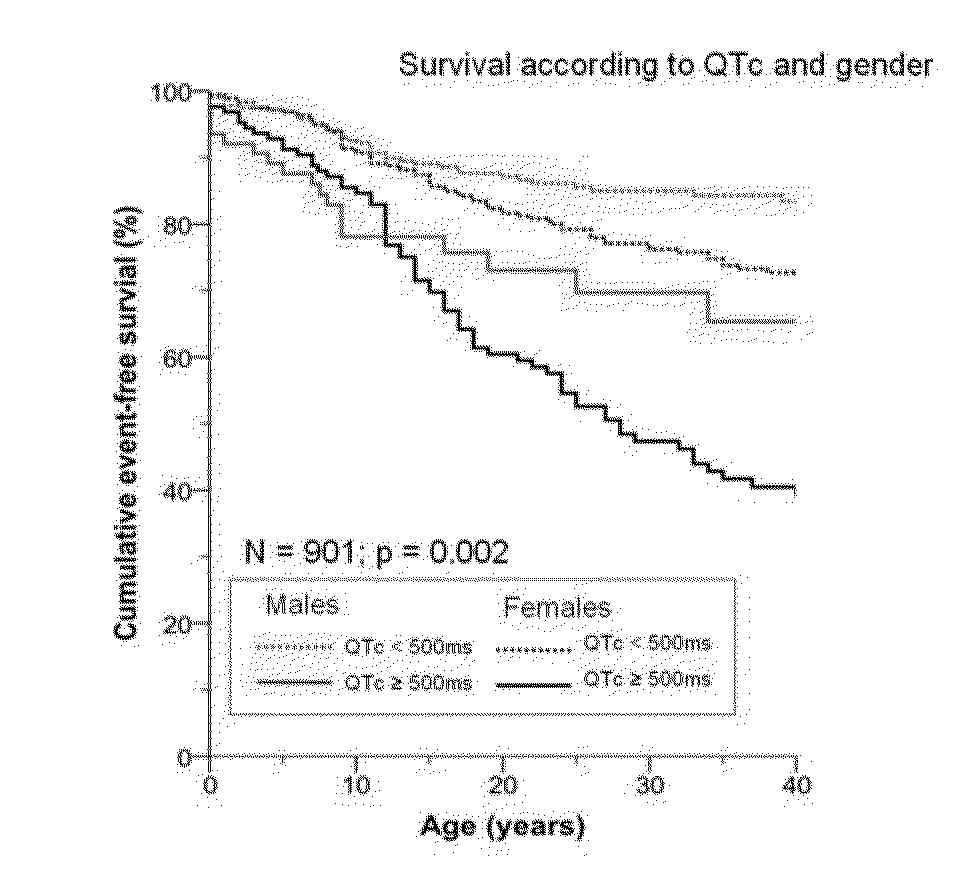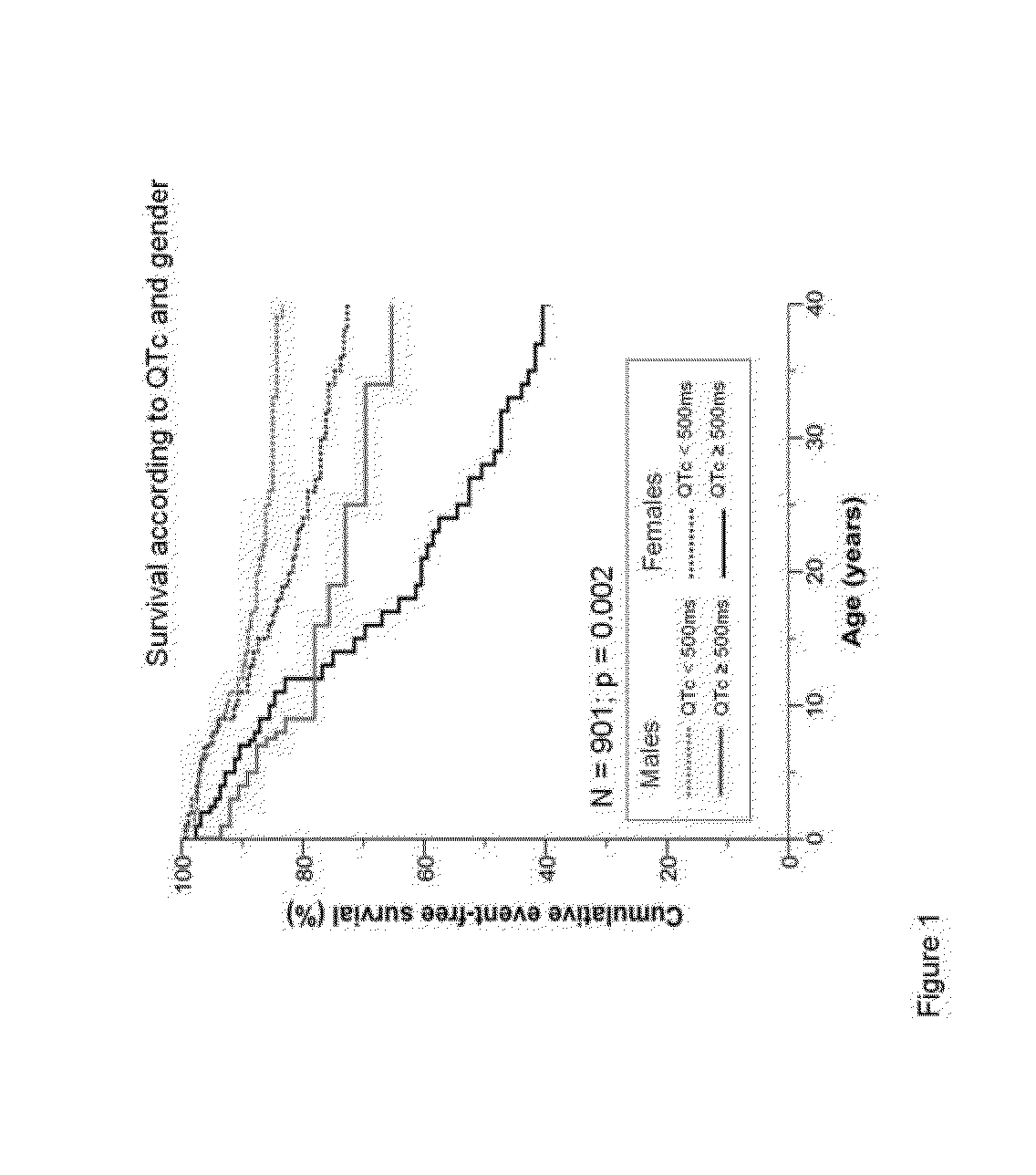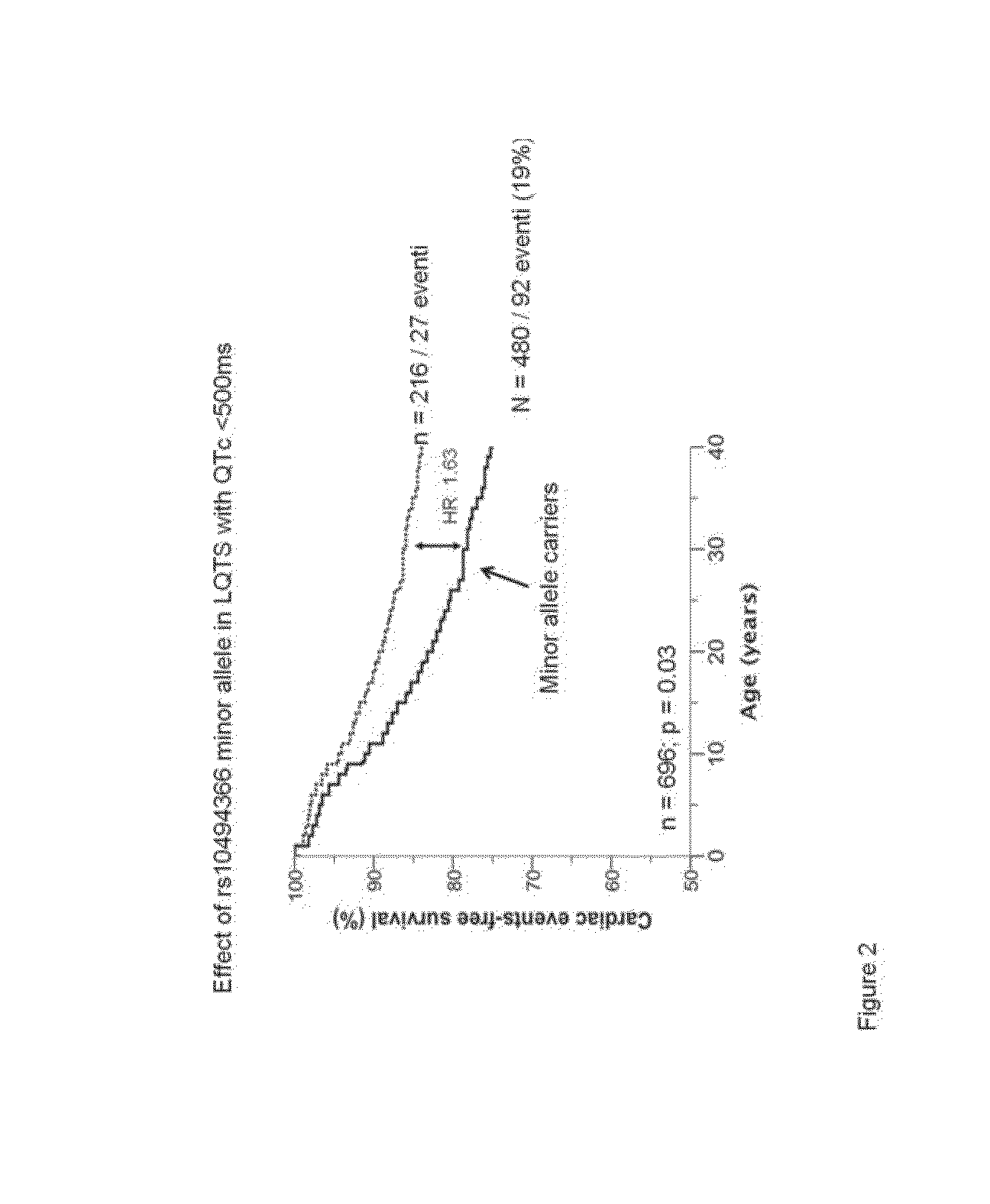Cardiac risk stratification by nos1ap genotyping
a technology of risk stratification and nos1ap, applied in the field of risk prediction, can solve the problems of lack of risk of cardiac events of the disease, polymorphism influence on the phenotype,
- Summary
- Abstract
- Description
- Claims
- Application Information
AI Technical Summary
Benefits of technology
Problems solved by technology
Method used
Image
Examples
example 1
[0047]Methods
[0048]Study Population
[0049]From our clinical data base and DNA bank of LQTS patients (4-6) we identified Caucasian individuals with a clinical and / or molecular diagnosis of Romano Ward LQTS who had been screened for mutations in the KCNQ1, KCNH2, KCNE1, KCNE2 and SCN5A genes (4-6) and for whom we had DNA and clinical data available on natural history, cardiac events and response to therapy. Nine hundred and one affected patients entered the study: 520 probands and 381 family members (216 first-degree relatives from 153 families). Families with more than one mutation were excluded.
[0050]Local and national laws regarding biomedical research, personal data protection and confidentiality were respected. The study protocol was approved by the Maugeri Foundation Ethical Committee and all participants or their legal guardians signed an informed consent.
[0051]Definitions
[0052]QT interval was measured at the enrollment ECG. Heart rate QT correction was performed (QTc) in lead I...
example 2
[0059]The characteristics of the 901 LQTS patients (55% women, mean age at last follow up of 31±19 years) from 520 families included in the study are shown in Table 1. LQTS gene mutations were identified in seven hundred and seventy patients (85%): KCNQ1 (n=421; 55%), KCNH2 (n=243; 32%), SCN5A (n=83; 11%), KCNE1 (n=21; 2.7%) and KCNE2 (n=2; 0.3%). In the remaining 131 patients no mutations were found in the five genes. Two hundred four patients experienced cardiac events.
TABLE 1Characteristics of Long QT-syndrome patients.LQTS patients / probands 901 / 520Women498 (55%)Age at last follow up (years ± SD) 31 ± 19Symptomatic patients204 (23%)Cardiac arrest 26 (13%)Syncope178 (87%)QTc (ms ± SD*)476 ± 46LQT-locus (gene)770 (85%)LQT1 (KCNQ1)421 (55%)LQT2 (KCNH2)243 (32%)LQT3 (SCN5A) 83 (11%)LQT5 (KCNE1) 21 (2.7%)LQT6 (KCNE2) 2 (0.3%)Not identified LQT-genotype131 (15%)NOS1AP SNPs MAFrs4657139 T > A0.42rs16847548 T > C0.29rs10494366 T > G0.45Haplotype frequency†AAA0.50aaa0.26aAa0.11No signif...
example 3
[0060]Minor Allele Frequency (MAF) of SNPs and Haplotypes,
[0061]The MAF of the SNPs rs4657139 T>A, rs16847548 T>C and rs10494366 T>G MAF were 0.42, 0.29 and 0.45, respectively, and these were in linkage disequilibrium (D′>0.800). Out of the 901 subjects, NOS1AP haplotypes could be estimated with a probability ≧0.80 for 887 patients with 197 events (22.2%). The AAA, aaa, aAa haplotypes were the only ones presenting with >0.10 frequency (0.51, 0.26, and 0.11, respectively). SNP MAFs and common haplotype frequencies are shown in Table 1. Haplotype analysis provided no information beyond what was indicated by SNP analysis alone; thus these data are not included here. Detailed haplotype frequencies are reported in Table 2. In the following table it appears that only TTT, ACG and ATG have a frequency >0.1. Clearly the low frequency of cardiac events and the sample size (forcedly limited as compared with population study in normal individuals), do not permit the data to reach sufficient st...
PUM
| Property | Measurement | Unit |
|---|---|---|
| Time | aaaaa | aaaaa |
| Fraction | aaaaa | aaaaa |
| Fraction | aaaaa | aaaaa |
Abstract
Description
Claims
Application Information
 Login to View More
Login to View More - R&D
- Intellectual Property
- Life Sciences
- Materials
- Tech Scout
- Unparalleled Data Quality
- Higher Quality Content
- 60% Fewer Hallucinations
Browse by: Latest US Patents, China's latest patents, Technical Efficacy Thesaurus, Application Domain, Technology Topic, Popular Technical Reports.
© 2025 PatSnap. All rights reserved.Legal|Privacy policy|Modern Slavery Act Transparency Statement|Sitemap|About US| Contact US: help@patsnap.com



